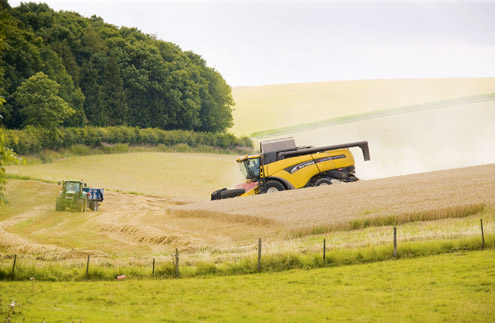Waxless wheats could help solve wheat yield plateau

Waxless wheat types and hybrids may have a future role in the quest to achieve higher yields and lift on-farm performance from its current plateau, according to researchers.
A team of scientists at the John Innes Centre in Norfolk headed by Cristobal Uauy (pictured) are exploring the additional yield potential of the gene responsible for altering leaf wax.
He has identified that a gene known as Inhibitor of wax 1 (Iw1) – which comes from a wild wheat type – is associated with increased yields and delayed senescence in UK conditions. With its distinctive appearance, giving varieties a “waxless” or greener look, it is already familiar to growers of certain Limagrain varieties, such as Shamrock and Crusoe.
However, Dr Uauy’s interest in Iw1 goes beyond its cosmetic “greener-looking” properties. He is investigating whether non-waxy wheats produce canopies that reflect less light and allow more to reach the lower leaves, producing the higher yields that have been associated with the dominant inhibitor gene.
As a result, the gene has been transferred through conventional crossing and marker technology into UK varieties, he reveals, so that waxless and normal types can be compared. Five of these will make their debut at the Cereals event, with waxless versions of Alchemy, Einstein, Hereward, Robigus and Xi19 all on show, produced by the John Innes Centre.
 “Our work has shown that these types have about a 4% yield advantage,” he reports. “Our focus now is to find out what’s causing this.”
“Our work has shown that these types have about a 4% yield advantage,” he reports. “Our focus now is to find out what’s causing this.”
He has been able to rule out any difference in water use efficiency, despite leaf wax type discrepancies. “However, we have seen that waxy wheats reflect more light than non-waxy ones, allowing more light to reach the bottom leaves, which is why we believe that the lower canopy could be responsible for the extra yield.”
The same gene is also responsible for an extra two days of flag leaf duration, or grain filling, he says. “This delayed senescence is also expressed when Iw1 is present. Now we need to unravel if the same gene is responsible for both effects.”
Waxless wheats are currently being tested in different environments, both with Velcourt and plant breeding companies, continues Dr Uauy. “An initial observation is that we don’t get the yield effect when the gene is put into Einstein – in fact, the reverse happens. So to date, there’s been a yield effect in five out of six varieties.”
The gene responsible for reducing leaf wax has been found at the end of chromosome 2B in wheat, he says. “And that segment of the chromosome also has the gene for orange wheat blossom midge resistance in it, so that particular resistance is lost in the waxless types at the moment.
“However, with marker technology, we can combine both Iw1 and midge resistance in one variety.”
Otherwise, the non-waxy varieties are 97% identical to the normal type, he stresses. “Wax formation in wheat happens later in the season, very close to anthesis, so there’s no effect on winter hardiness or crop development.”
Read all the news and reviews from Cereals on our event page.
Hybrid wheats could boost yields on farms where conventional types struggle to reach their potential.
Hystar, Hyteck and Hybery – all from the Saaten Union breeding programme – are being grown in plots on the Velcourt stand, where their inherent vigour will be obvious in their larger size, says John Poulton of Cropco, the UK distributor for hybrid wheat.
“Hybrid wheat produces a bigger plant, in every way,” he explains. “It means they are 4-6cm taller than conventional wheats, as well as having bigger root systems and thicker stems.”
Of the three varieties being profiled at the event, Hystar is a soft Group 4 type with early maturity, he adds. “Hyteck is a soft Group 3 biscuit type, with medium maturity, while Hybery is a potential breadmaking variety.”
Hybery is currently in NL1 trials, he says. “It’s the first hybrid wheat to be put through the national testing system for more than 10 years.”
The additional seed cost of £100/ha for a hybrid means that growers must get an extra 0.5t/ha to recoup their initial investment, he admits.
“But we would expect a far greater yield uplift than that, in the region of 2-3t/ha, although the site is important. Hybrid wheats should be grown on yield-limiting sites, where conventional types struggle to reach their potential.”
Work is also being done on seed rates and nitrogen timings for hybrid wheats, reveals Mr Poulton.
Sensing technology such as the N Sensor has long been used on cereals, but it may also have a role in variably applying nitrogen fertiliser to oilseed rape, according to Velcourt’s technical director Keith Norman.
This season has proved difficult, as small plants made it virtually impossible to get the light reflectance from the crop needed for the sensor to determine its nitrogen requirement, adds Velcourt farm manager Jason Turnbull, Lincolnshire.
Despite the difficulties of the current season, he is convinced the sensing technology and variable rate application is the right way for the farm business to go when it comes to crop inputs.
The N Sensor’s ability to differentiate between good and poor land and target fertiliser applications accordingly shouldn’t be underrated, believes Mr Turnbull. “It’s a real advantage in a lodging year, as it automatically reduces the amount of nitrogen applied to thick crop areas.”
He estimates that the technology costs about £4/ha. “In a good growing season, we probably do save money on our fertiliser bill. But our reasons for using it aren’t driven by cost savings, but for the management benefits it offers.”
At Cereals, an N Sensor will be travelling across a plot of oilseed rape on the Velcourt stand, to raise awareness of its ability to measure the crop’s nitrogen status and adjust fertiliser application rates in real time, says Mr Norman.
“We’ve used two different seed rates and nitrogen regimes,” he says. “So it will be determining the requirements of four different oilseed rape crops as it passes over the plots and altering application rates.”
The oilseed rape system uses an absolute N approach, rather than the target-based one for wheat. Growers put in their yield expectation, the crop’s growth stage and a figure for the amount of dead biomass, as well as the mineralisation potential, before switching on the spreader and variably applying fertiliser.
It allows for a two-way split programme in the canopy building phase, says Mark Tucker of Yara, with the later canopy manipulation duration application being a separate treatment.
And after the first application has been made, it assumes a second treatment will be made approximately four weeks later, he says. “It also allows for dead biomass, so even where crops have been ravaged by the weather, it can work. But there has to be some green in it.”
Mr Tucker reports that use of the N Sensor in oilseed rape gives a 3-4% yield benefit on average. “In one season, there can be as much as a 100kg/ha difference applied across a single field. The difficulty with oilseed rape crops has always been knowing which part of the field to use for your nitrogen calculations. This system takes away the guesswork.”

